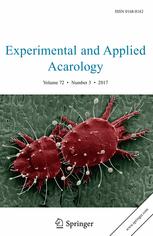Ver ítem
- xmlui.general.dspace_homeCentros Regionales y EEAsCentro Regional Santa FeEEA RafaelaArtículos científicosxmlui.ArtifactBrowser.ItemViewer.trail
- Inicio
- Centros Regionales y EEAs
- Centro Regional Santa Fe
- EEA Rafaela
- Artículos científicos
- Ver ítem
Amblyomma parvitarsum (Acari: Ixodidae): localities, hosts and host-parasite ecology
Resumen
Only a few aspects of the biology of Amblyomma parvitarsum Neumann are known. Adults of this hard tick species are parasites of South American camelids in the Andean plateau of Argentina, Bolivia, Peru and Chile and also in the Argentine Patagonia, but they have been also rarely found on other artyodactils and two species of birds. The larva has been collected from reptiles in northern Chile, whereas the hosts for the nymph remain unknown. On nine
[ver mas...]
Only a few aspects of the biology of Amblyomma parvitarsum Neumann are known. Adults of this hard tick species are parasites of South American camelids in the Andean plateau of Argentina, Bolivia, Peru and Chile and also in the Argentine Patagonia, but they have been also rarely found on other artyodactils and two species of birds. The larva has been collected from reptiles in northern Chile, whereas the hosts for the nymph remain unknown. On nine localities included within Altitude Tropical and Perarid Mediterranean ecoregions in northern Chile, we analyzed 237 reptiles, 285 birds, 624 rodents and 52 camelids for infestation with A. parvitarsum to calculate seasonal prevalence of this tick. We also reviewed the literature of this tick and three entomological collections for obtaining and summarizing all the information to date about this tick. None of the analyzed birds and rodents were parasitized with A. parvitarsum; however, seven over a total of ten reptile species that we caught were infested with the larva. In the camelid species Lama glama and Vicugna pacos we collected adult specimens of this tick. Larval prevalence was higher during fall (75 %) in Liolaemus pleopholis in the Altitude Tropical ecoregion. We also collected adult specimens of A. parvitarsum from camelid manure heaps during summer in Salar de Surire and Llullaillaco localities. Additionally, we also reviewed the literature of this tick and examined specimens in three entomological collections for obtaining and summarizing all the information to date about this tick. By this study, nine localities and seven new hosts are added for A. parvitarsum and we confirm reptiles as specific hosts of this tick larva.
[Cerrar]

Autor
Muñoz-Leal, Sebastian;
González-Acuña, Daniel;
Beltrán-Saavedra, L. Fabián;
Limachi, Juan M.;
Guglielmone, Alberto;
Fuente
Experimental and Applied Acarology 62 (1) : 91–104 (January 2014)
Fecha
2014-01
ISSN
0168-8162
1572-9702
1572-9702
Formato
pdf
Tipo de documento
artículo
Palabras Claves
Derechos de acceso
Restringido
 Excepto donde se diga explicitamente, este item se publica bajo la siguiente descripción: Creative Commons Attribution-NonCommercial-ShareAlike 2.5 Unported (CC BY-NC-SA 2.5)
Excepto donde se diga explicitamente, este item se publica bajo la siguiente descripción: Creative Commons Attribution-NonCommercial-ShareAlike 2.5 Unported (CC BY-NC-SA 2.5)

